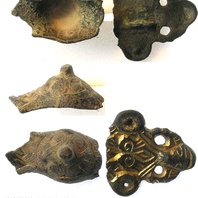
Viking Objects
Fragment of an Equal-Armed Brooch (SWYOR-FAFC04)
A fragment of a Viking Age equal-armed brooch found at Harworth Bircotes, Nottinghamshire. This fragment is the boss of the brooch and resembles brooches found at Birka, Sweden. Its decoration consists of a Borre style animal with gripping arms or legs. This is one of only six Scandinavian, Viking period equal-armed brooches recorded in England. For more information on Scandinavian jewellery in England check out our blog: Brooches, Pendants and Pins: Scandinavian Dress Accessories in England.
Read More
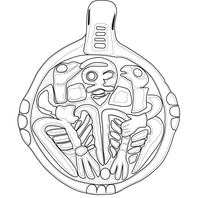
Viking Designs
Drawing of the Winteringham Pendant
A drawing of a cast silver, gilded pendant which has been interpreted as representing an image of Odin and his two ravens Huginn and Muninn. There are a number of close parallels which establish the wide currency of this subject group. These include numerous examples from Russia and two from Sweden, including some with silver gilding. A silver pendant with a related, but distinct design is known from Sjælland, Denmark. With some exceptions, pendants were generally worn by women as part of their Scandinavian dress.
Read More
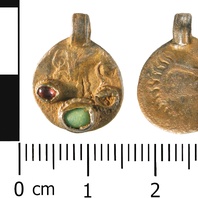
Viking Objects
Frankish Coin Pendant (WMID-24C235)
The coin that this pendant is made from was produced in North West France around 70-60 BC and is attributed to the Suessiones tribe. Later on the coin was adapted for use as a pendant and decorated with gilding and stone inlays. The colour and style of inlay give this pendant an early medieval dating and it is known that sometimes Iron Age coins were reused as pendants in Frankish jewellery. It is possible that it made its way to England prior to Viking incursions but it is equally likely that the Vikings brought this pendant with them as plunder after raiding in Frankia.
Read More
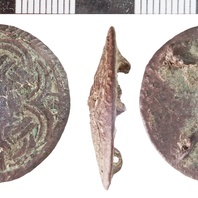
Viking Objects
Gilded Disc Brooch (NLM-783BCB)
This brooch is classed as Weetch Type 4 and resembles Viking-Age Terslev-style brooches. It is decorated with interlaced double strapwork and a cabled border and retains some traces of gilding. For more information on Scandinavian jewellery in England check out our blog: Brooches, Pendants and Pins: Scandinavian Dress Accessories in England.
Read More
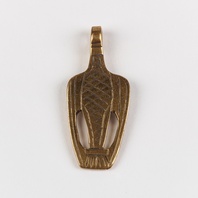
Viking Objects
Reproduction Bird Pendant
A reproduction bird pendant based on one found at Langford, Nottinghamshire. The nearest parallel to this type of brooch is one from Yaroslavl in Russia. The bird symbol, very similar to the one depicted on this pendant, was used by the Rurik dynasty which had started the conquest of Slavic lands in the mid 9th century and later formed the polity of Rus’. With some exceptions, pendants were generally worn by women as an accessory to Scandinavian dress.
Read More
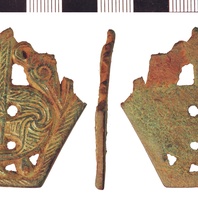
Viking Objects
Copper-Alloy Mount Fragment (NLM-92AFEC)
This copper-alloy mount fragment is likely from a horse harness and is decorated with closely-spaced diagonal hatching framing for a zoomorphic openwork design of four battling beasts around a central roundel. The front of the mount contains extensive traces of gilding. The object is considered an example of Irish or Hiberno-Norse metalwork and thus is associated with Viking activities around the Irish Sea region.
Read More
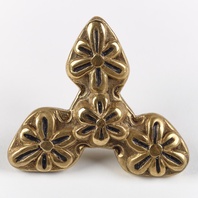
Viking Objects
Reproduction Trefoil Mount
A reproduction of copper alloy and gilded Carolingian mount with niello inlay found in Leicestershire. The mount has holes drilled through it for affixing to a surface, possibly a book, or perhaps to repurpose it as a pendant. These would have most likely been brought over by Vikings who had raided or traded on the European continent.
Read More
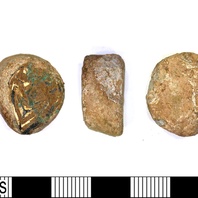
Viking Objects
Gilded Lead-Alloy Weight (LEIC-C6C96A)
The inset decoration of this weight is probably a reused fragment of an Irish or Anglo-Saxon object. Its importation and re-working is likely the result of Viking intervention. The distinction of weights by embedded objects or other embellishments in various media is a widely recognised feature of some early medieval weights. Weights are an important form of evidence for Viking Age commerce and the use of standards across the different economic systems within which Vikings were integrated. Many of the weights discovered, particularly ones in Ireland and those of Arabic type, suggest that a standardized system of weights existed in some areas. These standard weights, alongside standard values of silver, are what allowed the bullion economy of Viking-occupied areas to function. A bullion economy was a barter economy that relied on the exchange of set amounts of precious metal in various forms, such as arm-rings or coins, for tradeable goods, such as food or textiles. Each merchant would have brought their own set of weights and scales to a transaction to make sure that the trade was conducted fairly.
Read More
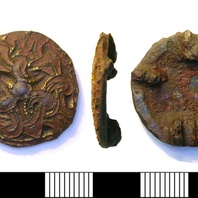
Viking Objects
Copper-Alloy, Gilded Disc Brooch (LEIC-E7A016)
A copper alloy, gilded brooch with a zoomorphic design in the Borre style. This brooch was probably made in Denmark and brought to England. For more information on Scandinavian jewellery in England check out our blog: Brooches, Pendants and Pins: Scandinavian Dress Accessories in England.
Read More
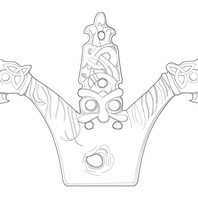
Viking Designs
Drawing of a Mystery Item
This is a drawing of a gilded, copper alloy object that was clearly affixed to something else. The gilding shows that it was high status but its function remains a mystery.
